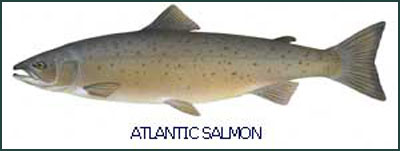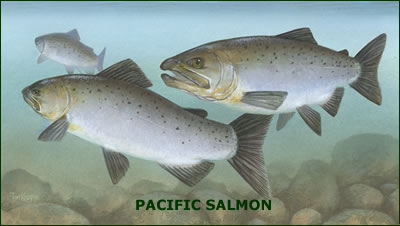Introduction to Salmon Fishing
Largely as a result of successful efforts
to stock waters with salmon, these incredible
game fish can be caught in the Great Lakes
a swell as inland on the maritime coasts.
Of course, salmon are one of the most popular
gamefish in North America and can be broken
down into two major categories: the Pacific
salmon (chinook, coho, pink, sockeye and
chum) and the Atlantic salmon. The Pacific
salmon generally enter streams from northern
California up to Alaska. The Atlantic salmon,
on the other hand, enter streams from New
York up to Labrador. Both are referred to
as an anadromous fish, meaning they spend
their adult life at sea and then return
to freshwater streams to reproduce. Follow
the links to each for detailed information
on the species and the techniques to catch
them.
Individual Species Overview
Atlantic Salmon
 Named by early Romans, the Atlantic salmon (salmo salar), or "leaper," is arguably the most sought-after game fish in North America. Offering excellent table fare, the Atlantic salmon's original range is from Greenland to Cape Cod in the Atlantic Ocean and from Russia to Portugal. In Canadian lakes, resident landlocked Atlantic salmon are called Ouananiche. Named by early Romans, the Atlantic salmon (salmo salar), or "leaper," is arguably the most sought-after game fish in North America. Offering excellent table fare, the Atlantic salmon's original range is from Greenland to Cape Cod in the Atlantic Ocean and from Russia to Portugal. In Canadian lakes, resident landlocked Atlantic salmon are called Ouananiche.
Fishing Techniques
The only legal method of catching Atlantic salmon is to use artificial flies. Complete Atlantic fishing outfits range from reasonably priced rods and reels to elaborate thousand-dollar outfits. A decent salmon fishing outfit consists of a well-made 8 ½-foot trout rod with a strong backbone and a reel with a 3¼-inch diameter spool with one hundred and fifty yards of fifteen-pound test backing. Under normal water conditions use a 7½-foot leader tapered to a tippet of four pounds (2X). When conditions are low and clear use a 9½-foot leader.
Wet or dry flies will catch Atlantic salmon, though the traditional patterns for both flies are difficult to tie. The modern patterns, simple to tie and comprising little more than a fluorescent body and bright wing, are more effective for all fly-fishing levels. Small No. 6 and No. 8 flies cast without a tail (in a "butt pattern") are easy to tie and produce under average water conditions. In high and discoloured waters, larger No. 4 flies attract the fish, while in low and clear conditions smaller No.12 flies are successful enticements. Generally, darker flies work best on clear bright days and brighter flies coax strikes on gray days and in murky waters.
A guide is invaluable when fishing unfamiliar rivers and streams. Atlantic salmon congregate in areas specific to each river, but generally the fish prefer moderately flowing rivers near obstructions close to the bank in waters between 65º F and 70º F. Edges of areas where the current changes, over gravelly bottoms submerged in high waters, and in high water in long expanses of flat water below large pools are all casting hotspots. Fish the deep pools from a boat or canoe, anchoring at the head of the pool and casting 30 or 40 feet to different spots in the pool. Then drift slightly downstream, and cast again to the waters previously untouched. Cast to as much water as possible, whether from boat or shore. Some anglers prefer to wait before casting twice to an interested fish, but many strikes also occur after consecutive fly casts. If a fish appears interested in a fly and moves in the fly's direction but does not strike, often changing the size of the fly will result in an energetic strike.
Salmon fishing differs considerably from trout fishing. While trout anglers use the approach of presenting flies to actively feeding fish, several casts are often required to persuade or anger salmon to strike. Trout like to sit in familiar areas of the stream where the fast current brings food to the waiting fish. Salmon, on the other hand, swim to different stretches of the river and stream, and rest in the calm lengths away from the drifting current. Therefore, many trout anglers avoid these salmon hotspots, unaware that the salmon are not searching for food carried by the current.
Large dry flies that will send trout swimming for cover are usually great producers of salmon strikes. Salmon usually hook themselves on dry flies, so anglers must be careful not to set the hook instantly, as trout anglers are accustomed. To catch hooked salmon that run straight downstream and fight leaping in the air to shake the fly free, try lowering the tip of the fishing rod as the fish leaps, to prevent the fish from falling on the tight line and breaching the tippet. Use the force of the current to fatigue hooked salmon that run upstream. When the fish has tired, lead it to a "tailor" (a noose that slips over the fish's tail) and expect to give line as the fish approaches. Sometimes salmon are spooked by the looming appearance of the angler and will gather enough energy to make a desperate rush downstream.
Pacific Salmon
 There are six species of Pacific salmon: chum or dog salmon (oncorhynchus keta); sockeye or blueback salmon (oncorhynchus nerka); humpback or pink salmon (oncorhynchus gorbuscha); coho or silver salmon (oncorhynchus kisutch); chinook salmon (oncorhynchus tshawytscha); and kokanee (landlocked sockeye salmon lacking anadromous instincts). There are six species of Pacific salmon: chum or dog salmon (oncorhynchus keta); sockeye or blueback salmon (oncorhynchus nerka); humpback or pink salmon (oncorhynchus gorbuscha); coho or silver salmon (oncorhynchus kisutch); chinook salmon (oncorhynchus tshawytscha); and kokanee (landlocked sockeye salmon lacking anadromous instincts).
Chinook Fishing Techniques
Offshore fishing equipment and techniques vary. In the spring, deep trollers use down riggers or cannon balls for the deep cohos and chinook. The fish move toward the surface as the season advances, and peak fishing occurs in late summer. When the fish are in the ten to twenty-feet-deep range, try plastic or metal diving planes.
Offshore salmon bait and lures are matters of individual preference; the same bait or lure may work regardless of the fished depth. Try rigging small herring or anchovy bait. To ensure that the bait does not spin and twist the line, pull the eye of the hook through the anal vent, through the center of the body, and out of the mouth, and then sew the mouth of the bait firmly to the hook.
Other baits and lures to try are smelt, cut mackerel, squid; silver or gold spoons, shiny lures of any colour, and shiny long-bodied streamer flies for surface-feeders.
"Mooching" for salmon consists of an exaggerated jigging motion while over an area believed to hold fish. Use an eight or nine-foot boat rod with a fast tip, a good backbone, a medium-weight star-drag reel with at least 200 yards of 20 to 30-pound test line. Add less than an ounce of weight one and a half feet above the bait (plug-cut baits or whole herring, for example) or spoon and lower it to the desired depth (usually 20 or 40 feet). With the reel in gear, sweep the rod upward in long arcs from the water level to above your head. The salmon in the area often take the bait.
|